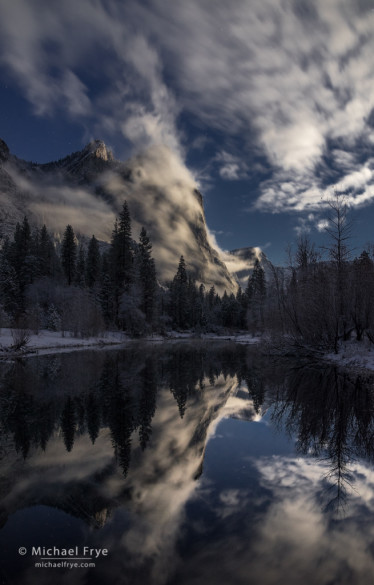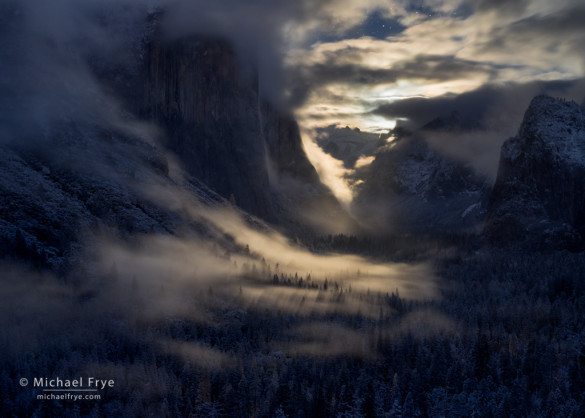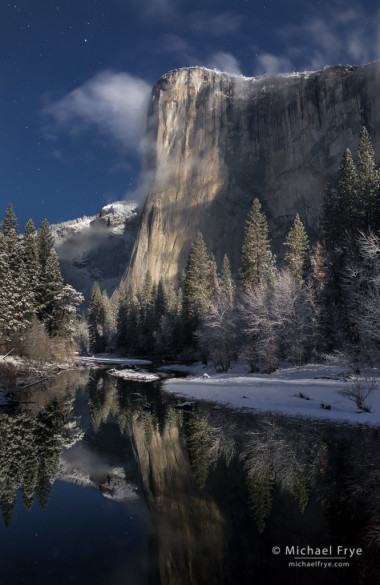Last week another storm brought rain and snow to Yosemite. We didn’t get a lot of precipitation, but after the cold front passed through, snow levels dropped down to near 3,000 feet, and Yosemite Valley received about two inches of snow.
Checking the satellite images online Wednesday afternoon it looked like the skies might clear before sunset, so I headed up to Yosemite Valley. It didn’t quite happen; I saw some breaks in the clouds, and faint sunlight hitting Sentinel Rock, but that was all. However, I knew that the nearly-full moon was due to rise about 20 minutes after sunset, so I headed up to Tunnel View to see if the skies might clear in time for the moonrise.
Before the moon came up I photographed the snowy scene by the light of the fading dusk. Then I noticed clouds in the distance lit by the rising moon. Soon some clouds overhead were catching the moonlight. Then the moon lit the mist on the valley floor.
This was just a spectacular sight – something I took time to appreciate during 15- and 30-second exposures. I’d never seen such a beautiful clearing storm lit by the rising moon. I’d also never seen that lighting angle. In winter the sun rises way over to the right, behind Cathedral Rocks. But the full moon in winter takes a path similar to the summer sun, rising much further to the left. On Wednesday evening it came up just to the left of Half Dome, pouring light down the length of the valley and hitting that mist on the valley floor – a moment shown in the photograph at the top of this post. Luckily the moon remained hidden behind clouds for awhile, otherwise the contrast between the bright moon and dark foreground would have been too difficult to handle.
Soon after I made that photograph the moon appeared through a gap in the clouds, and the contrast became too extreme, plus I started to get lens flare (yes, the moon can create lens flare!). So I packed up and headed down to a spot along the Merced River, where the clouds and mist lingered for awhile as I photographed Three Brothers and El Capitan (shown below).
Moonlight looks very different to our eyes than sunlight. First, the light is much dimmer. Second, we don’t see much color by moonlight, because it’s too dark for the color-sensitive cones in our retinas to work, and we see only with our color-blind rods.
But a photograph taken by moonlight can look very much like a daytime photograph. A long exposure can make the image quite bright, and the camera has no problem recording color at night. So in processing these images I tried to make them look more like I saw them. That meant keeping them a bit dark overall. I also used a cooler white balance and less color saturation than I would with daytime images, to give the photographs more of the silvery look that you see with your eyes. And I tried to bring out stars as much as possible, though that was challenging, as the bright moonlight tended to wash out the stars.
The photograph at the top of this post was particularly challenging to photograph and process because of the high contrast. I bracketed three exposures for this scene, and later blended those frames together in Photoshop using layer masks. (The exposures were 8 seconds at f/8, 400 ISO; 30 seconds at f/8, 400 ISO; and 30 seconds at f/5.6, 800 ISO.) The clouds and mist moved considerably during the long exposures, so HDR probably would have created lots of ghosting, but the manual blend in Photoshop worked well.
It was a special, magical night. I was glad to be a photographer; what other pursuit involves deliberately seeking out our planet’s most beautiful moments?
— Michael Frye

Three Brothers by moonlight during a clearing snowstorm, Yosemite, Wednesday evening. 20 seconds at f/4, 1600 ISO.
Related Posts: Yosemite Falls by Moonlight; Moonbeams Over Yosemite Valley
Did you like this article? Click here to subscribe to this blog and get every new post delivered right to your inbox!
Michael Frye is a professional photographer specializing in landscapes and nature. He is the author or principal photographer of The Photographer’s Guide to Yosemite, Yosemite Meditations, Yosemite Meditations for Women, Yosemite Meditations for Adventurers, and Digital Landscape Photography: In the Footsteps of Ansel Adams and the Great Masters. He has also written three eBooks: Light & Land: Landscapes in the Digital Darkroom, Exposure for Outdoor Photography, and Landscapes in Lightroom: The Essential Step-by-Step Guide. Michael has written numerous magazine articles on the art and technique of photography, and his images have been published in over thirty countries around the world. Michael has lived either in or near Yosemite National Park since 1983, currently residing just outside the park in Mariposa, California.











Wow, Michael. These images are stunning! You’ve conveyed the magical feeling well. Wish I could’ve been there.
Thanks so much Vivienne, and I wish you could have been there too.
Michael, those are all beautiful, but I really like the last one the best. Were the last two shot from Cathedral Beach?
Thanks John! Near Cathedral Beach – the next bend upriver.
Thanks. I think I know the spot but haven’t had the best of luck there. Hopefully a higher flowing Merced might change that this spring.
Wow, just spectacular Michael! Thank you for sharing.
Thanks Lisa!
OutSTANDing ! Besides the light, the MOVEment in the picture is amazing … Destined to become a Classic, Michael.
Thank you Andrys!
I loved these pictures. I hope to see Yosemite again before I die. Its so beautiful.
Thank you Lucile, and I hope you get back to Yosemite soon.
Just when you think you’ve seen it all, Yosemite amazes again. Thanks Michael for your outstanding skill, hard work and experience in photographing and sharing a magical scene that only a few could capture!
Thanks so much Kanwarjit!
I admire your work, Michael. This is stunning and makes me want to come back to Yosemite again soon!!! 🙂
Thanks Suzy, and I hope you do get back to Yosemite soon!
Thank you
You’re welcome. 🙂
That is some fantastic work. Beautiful images Michael.
Thank you Terry!
Michael-
Absolutely awesome!
This is some of your best work yet!
Thanks for posting.
P.S. Appreciate you giving us your exposure settings. Makes me want to try it myself as I have previously had “hit or miss” results.
Thanks very much Bill! Don’t expect the settings I used to work for you, as the settings will vary based on how high in the sky the moon is, how full it is, the lighting angle, whether the moonlight is filtered by clouds, and the amount of contrast in the scene. As always, I used the histogram and blinkies to judge the exposures.
You’re so correct about the exposure. But its a good place to start for test shots.
Thanks again.
Do you process these photos in Photoshop or just lightroom?
I LOVE your work. Also sincerely appreciate that you share your knowledge. I am in the process of reading your books and learning how to use lightroom to post-process the shots I had. As a beginner in photography, I was so frustrated that I do not know what I am doing with my photos in LR. Your books/videos explained the lightroom so well, not just saying push sliders this way or that way, but why and what they do. After finish reading your book, I will re-process my the photos I took.
Wish I had time to attend your workshops!
Again, thank you sincerely.
Thanks very much Bailing – I’m very glad the Lightroom ebook helped you. As I said in the post, I used Photoshop for the first image to blend the three different exposures together. The other two were processed entirely in Lightroom.
You are so kind, Michael.
Michael those are stunning photos. I especially love El Capitan by moonlight. How fortunate you were to be there that night and that you knew exactly the locations for the best opportunities with the light. Love all three! I appreciate you sharing your work and knowledge with us. You and you photos are exceptional!
Thanks so much Carol!
Michael.
I also wanted to post here an idea. I was just thinking the other day about your work. Recently the thought came to me, does Michael ever get tired of Tunnel View, or Clouds Rest, or Half Dome?
Could anyone become bored, or complacent in the face of such heroic beauty?Yosemite is your small world, but of course, it is so large to most who have seen it up close. But you have seen it so often, could you ever say enough with El Capitan, The Three Brothers; and the Mariposa Grove of trees?
There are photographers like Galen Rowell who traveled all over the world. Not only that, he climbed all those mountains to grab those great moments of beauty. Many of us think, that we need to travel beyond our backyards to make great statements.
There are small woods near by me that I have photographed for 30 years. I know every tree, branch, and leaf in this small world. But to walk through those woods every fall is still a thrill.
Your moonlight view of the valley is so extraordinary, and so lovely. Day after day you have showed up, trying to find something to record for all time of your home.
You had paid your dues, and were rewarded. Thanks for keeping on with your work, as it gives all of us inspiration to do the same.
Bruce
Bruce, thanks for posting your comments, and posing this question. For me, the answer is yes and no. On a clear, sunny day I wouldn’t think of photographing from Tunnel View, because I’ve photographed that view (and all the other standard views in Yosemite) with more interesting light and weather. During a clearing storm I’m definitely not tired of photographing Tunnel View, or any of the other Yosemite icons, because then things are changing and always different, and there’s the potential for a special moment with light that I haven’t seen before and couldn’t predict.
Having said that, however, I sometimes find it hard not to repeat myself. When you’ve photographed a place as much as I’ve photographed Yosemite, you have to look more deeply to find something new, which is an interesting exercise. Of course I’ve been photographing intimate landscapes in Yosemite forever, so that in itself is nothing new, but I keep finding new locations for that kind of work (at least new to me), or discovering interesting small-scale lighting events that I hadn’t noticed before at familiar spots, or just noticing new subjects and seeing their potential for the first time. And that desire to do something new has also pushed me to make more photographs of Yosemite at night recently – these photos being examples of that, along with others I’ve posted over the last couple of years. And I have some other ideas. 🙂
I’m always encouraging people to photograph places near their homes, because we usually make our best images of subjects we’re most familiar with, and have a connection with.
Bruce and Michael,
It is so true that familiarity breeds improvement! The three most important aspects of a good landscape photograph are subject, composition and light. Only the first is unchanging – at least during a human lifespan. Living where I do my “go-to” place is Garden of the Gods with a background of Pikes Peak and I have been photographing them for close to 40 years. Still I find new and interesting ways to do so, even when the sky is blue!
Jim
Thanks for chiming in Jim. I’m glad that you have a great location nearby that you can go back to again and again. I’ll just add that landscape subjects are not as unchanging as we sometimes assume. There are a number of dogwoods along the Merced River in Yosemite Valley that I’ve photographed over the years that are either gone or completely changed. The river keeps eroding its banks and the dogwoods keep falling in!
Michael,
Good point! Water, wind, fire, earthquakes, volcanoes and other phenomena do, indeed, play a role.
Jim
Hi Michael,
You’ve certainly been having fun!! They are all wonderful. For some reason, the El Cap shot really grabs my attention.
Thanks for sharing,
Doug
Yes indeed Doug – thanks!
Hello Michael,
The pictures you shared in this post are amongst the best Yosemite images I’ve ever seen and the post processing is fabulous. I was wondering if you are intending to create black and white versions and share them via a future post?
I admire your photography and dedication; your work is a constant source of inspiration for me.
Take care
Richard
Thanks so much Richard! I don’t typically do both color and black-and-white versions of the same image; I pick which interpretation I think works best for each photograph. With these photos I preferred color, but they could very well work in black and white too.
Stunning, Michael! I’m trying to catch up with your posts now that I can’t seem to get the subscription to work automatically. I love how the clouds sweep through this image. Simply stunning.
Thanks so much Brenda! That’s very nice of you make a special visit. 🙂 Sorry we haven’t been able to figure out the problem with Comcast. It’s very frustrating from my end too, but I’m still working on it.